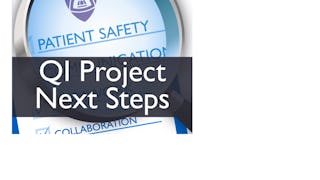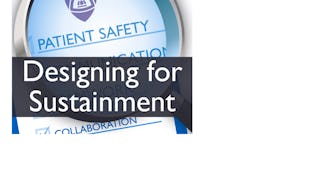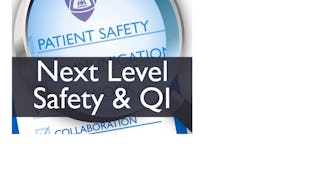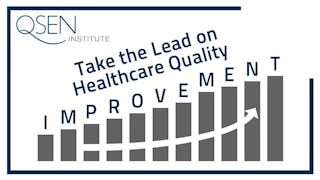This course provides students with a set of tools and methodologies to plan and initiate a Problem Solving or Quality Improvement project. The first module presents methods for selecting, scoping and structuring a project before it is even initiated. It also introduces the project classifications of implementation and discovery. The second module describes the A3 problem solving methodology and the tool itself. Further in that same module, the student is shown tools to identify problems in flow, defects, and waste and to discover causes, brainstorm, and prioritize interventions. Module 3 shows a methodology within the implementation class. These methods are designed to overcome emotional and organizational barriers to translating evidence-based interventions into practice. The fourth and last module looks at one more way to approach improvement projects in the discovery class. These tools are specifically for new, out-of-the-box design thinking.


Planning a Patient Safety or Quality Improvement Project (Patient Safety III)
This course is part of Patient Safety Specialization

Instructor: Bob Hody
10,896 already enrolled
Included with
(198 reviews)
What you'll learn
Describe approaches for selecting and scoping a patient safety or quality improvement project.
Compare and contrast QI/PI approaches: A3 Thinking, Design Thinking, and Translating Research into Practice (TRiP).
Create a project charter or A3 using SMART goals.
Explain the usage of several root cause identification tools in the course of running a project.
Skills you'll gain
Details to know

Add to your LinkedIn profile
See how employees at top companies are mastering in-demand skills

Build your subject-matter expertise
- Learn new concepts from industry experts
- Gain a foundational understanding of a subject or tool
- Develop job-relevant skills with hands-on projects
- Earn a shareable career certificate

There are 4 modules in this course
In this module, you will see the process for defining, scoping, selecting and prioritizing improvement initiatives. Further, you will learn necessary team characteristics and organizational support structures.
What's included
7 videos1 assignment
In this module, you will be introduced to the process and format of A3 problem solving. You will learn the key components of an A3 for to define and start an improvement project to maximize your chances of success. Additionally, a set of tools will be covered that are commonly used in the actual improvement project, which will identify underlying process issues and their root causes.
What's included
9 videos1 assignment
This module explains the Translating Research into Practice (TRiP) model. It is a methodology to facilitate the adoption and use of evidence-based therapies. This model itself uses a collaborative knowledge translation model for wider sharing of knowledge into practice.
What's included
7 videos1 peer review
In this module, we will cover a process called Design Thinking. It is a human-centered design approach that fosters out-of the-box thinking to create innovative solutions. The process builds the design iteratively in a highly collaborative team approach. The five steps of design thinking will be covered: Learn, Define, Ideate, Protype, and Test.
What's included
10 videos
Earn a career certificate
Add this credential to your LinkedIn profile, resume, or CV. Share it on social media and in your performance review.
Instructor

Offered by
Explore more from Healthcare Management
 Status: Free Trial
Status: Free TrialJohns Hopkins University
 Status: Free Trial
Status: Free TrialJohns Hopkins University
 Status: Free Trial
Status: Free TrialJohns Hopkins University
 Status: Preview
Status: PreviewCase Western Reserve University
Why people choose Coursera for their career




Learner reviews
198 reviews
- 5 stars
84.84%
- 4 stars
10.10%
- 3 stars
3.53%
- 2 stars
1.01%
- 1 star
0.50%
Showing 3 of 198
Reviewed on Aug 18, 2020
This course is really helpful in planning the project. It will make you brainstorm yourself and you will eventually end up doing the project by yourself. It really boosted up my confidence.
Reviewed on Dec 17, 2021
very fun learning experience would recommend this course
Reviewed on Aug 6, 2020
Great course helped me a lot to learn how to start A3 project

Open new doors with Coursera Plus
Unlimited access to 10,000+ world-class courses, hands-on projects, and job-ready certificate programs - all included in your subscription
Advance your career with an online degree
Earn a degree from world-class universities - 100% online
Join over 3,400 global companies that choose Coursera for Business
Upskill your employees to excel in the digital economy
Frequently asked questions
To access the course materials, assignments and to earn a Certificate, you will need to purchase the Certificate experience when you enroll in a course. You can try a Free Trial instead, or apply for Financial Aid. The course may offer 'Full Course, No Certificate' instead. This option lets you see all course materials, submit required assessments, and get a final grade. This also means that you will not be able to purchase a Certificate experience.
When you enroll in the course, you get access to all of the courses in the Specialization, and you earn a certificate when you complete the work. Your electronic Certificate will be added to your Accomplishments page - from there, you can print your Certificate or add it to your LinkedIn profile.
Yes. In select learning programs, you can apply for financial aid or a scholarship if you can’t afford the enrollment fee. If fin aid or scholarship is available for your learning program selection, you’ll find a link to apply on the description page.
More questions
Financial aid available,
¹ Some assignments in this course are AI-graded. For these assignments, your data will be used in accordance with Coursera's Privacy Notice.

